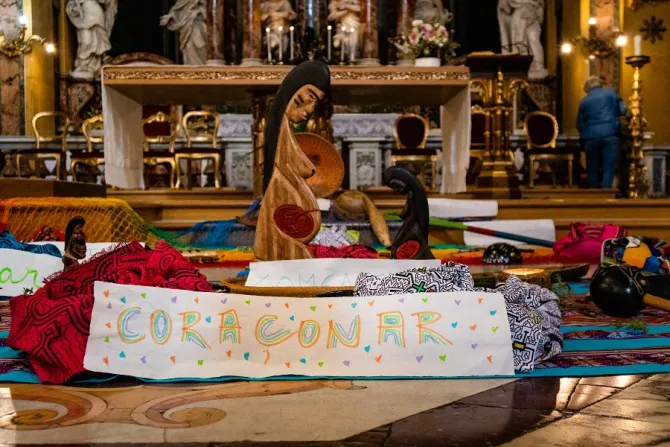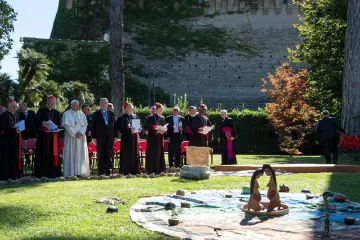Vatican City, Oct 16, 2019 / 11:40 am
At a "moment of Amazon spirituality" Oct. 16, in a church just down the street from St. Peter's Square, a woman told the Amazonian folk tale of a pink river dolphin who seduced a village girl.
The story, and the conversation that ensued, is a poignant example of questions raised about the Vatican's Amazon synod, and about the meaning of calls to "inculturate" the Gospel.
She was seated on a low stool, on a cloth mat, in the aisle leading to the sanctuary of Santa Maria in Traspontina, a Carmelite Church built five centuries ago. Two indigeneous people sat behind her. Between them was a now-controversial wooden figure of a pregnant woman, along with carved bowls filled with water, pieces of woven netting, and small carved statues.
The storyteller's version of ancient mythical story in the Amazon goes like this:
There is a pink river dolphin deep in the Amazon. When he hears the sound of drums, he sometimes emerges from the water, to enter villages and to dance with village people. He takes to land to seduce young women in the villages.
To young girls the dolphin appears as a handsome stranger, a foreigner, a white man. To everyone else he still looks like a dolphin.
Eventually, the mysterious stranger seduces a young woman from the village. In some tellings, she becomes pregnant. In other versions, she simply falls in love. But in every case, she finds herself compelled to the river. She has fallen under a spell. If the spell can't be broken, sometimes by a local shaman, she will throw herself into the river, and there she will become a mermaid.
When she finished telling her story, the storyteller asked those gathered in the church to share what the story means to them.
"What does it mean to you?" is not the same question as "What does it mean?" Both questions have merit, of course. And mythical and folkloric tradition has a place in every culture, in which new meanings and ideas can emerge from old stories.
At today's Amazon spirituality gathering at Santa Maria in Traspontina. #AmazonSynod pic.twitter.com/J0C4wenh0m
- JD Flynn (@jdflynn) October 16, 2019
Still, the critics of the liturgies, ceremonies, and rituals surrounding the Amazon Synod say those events have been plagued by ambiguity, by a sort of postmodern subjectivism, and by an absence of the proclamation of the Gospel and reference to sacred revelation.
Some of that criticism is hyperbolic and overwrought. And, in fact, synod-connected events expressing Amazon spirituality, including the controversial Oct. 4 tree-planting attended by Pope Francis, have included readings from scripture, obviously Catholic prayers, and reflections or preaching on the saving mystery of Jesus Christ.
But the identifiably Christian aspects of the rituals have often taken place alongside unidentified images and sculptures, and with the incorporation of rituals of unclear origin. That has led to confusion.
Journalists asking "What does this mean?" have heard, in response, another question: "What does this mean to you?"
On Oct. 16, a journalist asked for clarity at a Vatican press conference about the carved image, first seen at the tree-planting ceremony, and featured at other events connected to the synod. The image had been described by at least one western Catholic journalist as the Virgin Mary and by Getty International as a pagan goddess.
(Story continues below)
Fr. Giacomo Costa, a synod spokesman, said the image is not the Virgin Mary, but a female figure representing life. Paolo Ruffini, a Vatican communications officially, said that in his personal view, the image seems like that of a tree, which is, he said, a kind of "sacred symbol."
Ruffini committed to learning more, but offered a qualifier that has become a familiar line at the Amazon synod: "We know that some things in history have many interpretations."
A journalist asking bishops about the image Oct. 7 got a more nebulous answer.
"We all have our own interpretations: the Virgin Mary, the Mother Earth...probably those who used this symbol wished to refer to fertility, to women, to life, the life present among these Amazonian people and Amazonia is meant to be full of life. I don't think we need to create any connections with the Virgin Mary or with a pagan element," Bishop David Martínez De Aguirre Guinea of Peru said at a Vatican press conference.
Among the journalists, observers, and other interested parties watching the synod, there are clearly two perspectives on the carved image, and the controversy surrounding it.
One camp seems to say that this kind of ambiguity represents the ordinary process of inculturation. They see in the ambiguity the complicated reality of proclaiming the Gospel in an unfamiliar context, and they are eager to affirm points of similarity between Amazonian spirituality and Christianity. If a carved image highlights those points, they say, it should be celebrated, even if every question doesn't have a clear answer. Being unduly dogmatic, they suggest, is a kind of hostility to the good will of the synod and its participants.
The other camp, those who would usually be classified as conservatives, are more skeptical. They have begun to ask whether the synod's participants have thought through the limits of inculturation, or the consequences of ambiguity on issues that seem close to religious syncretism or even tacit consent to functional idolatry.
That camp is concerned that legitimate inculturation has been reduced to an ambiguous and undirected blending of Christian and local customs, with very little rational explanation of the theology behind emerging praxes. Some ask whether the result of such a process can really be Christianity at all.
The more skeptical observers say that the Catholic Church teaches that subjective reflection must be complemented by rational analysis and coherent proclamation, especially in the context of religious practice, where meaning, fundamentally, is derived from revelation. They say that while inculturation is important, the haphazard blending of customary and Christian symbols leads to religious rituals that can only be interpreted subjectively.
While the lines among the various camp followers are clear, it's not clear what most of the synod participants think, in large part because the flow of information at the Amazon Synod is tightly controlled, and the messaging from the press office has for the most part seemed curated.
Even the synod participants who have talked about inculturation, and the controversy surrounding the image and the Amazon spirituality events, have not done so with particular theological depth.
At an Oct. 12 press conference, Bishop Rafael Cob García of Ecuador told CNA that inculturation is a process, not something that happens overnight.
Inculturation requires "trying to get into their frame of mind, and then, after a very long time, you can see what is connected with the Gospel," Brazilian Bishop Adriano Ciocca Vasino added.
This is done always, he said, "with reference to Christ."
Bishops have not commented on the desired results of inculturation, or the principles that should guide it, or way to prevent it from becoming syncretistic, or undermining evangelization. Their failure to do so has made the skeptical camp all the more skeptical.
What bishops have explained is that inculturation, however they understand it, takes a long time.
"If you follow a long pathway, trying to understand and respect, to the point of understanding the soul of their spirituality, then you get really interesting results," Vasino said. "To understand, we must delve deeply."
Catholics at the Vatican synod may soon give more thought to the story of the pink dolphin.
They'll ask whether the synod fathers have been attracted by the idea of inculturation without seeing its dangers. They'll wonder if the Church must throw herself into a river to understand how the story of a rapacious pink dolphin is "connected with the Gospel." The answers have not yet been forthcoming.




